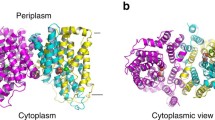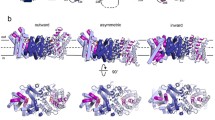Abstract
The SdcF transporter from Bacillus licheniformis (gene BL02343) is a member of the divalent anion sodium symporter (DASS)/SLC13 family that includes Na+/dicarboxylate transporters from bacteria to humans. SdcF was functionally expressed in Escherichia coli (BL21) and assayed in right side out membrane vesicles. ScdF catalyzed the sodium-coupled transport of succinate and α-ketoglutarate. Succinate transport was strongly inhibited by malate, fumarate, tartrate, oxaloacetate and l-aspartate. Similar to the other DASS transporters, succinate transport by SdcF was inhibited by anthranilic acids, N-(p-amylcinnamoyl) anthranilic acid and flufenamate. SdcF transport was cation-dependent, with a K 0.5 for sodium of ~1.5 mM and a K 0.5 for Li+ of ~40 mM. Succinate transport kinetics by SdcF were sigmoidal, suggesting that SdcF may contain two cooperative substrate binding sites. The results support an ordered binding mechanism for SdcF in which sodium binds first and succinate binds last. We conclude that SdcF is a secondary active transporter for four- and five-carbon dicarboxylates that can use Na+ or Li+ as a driving cation.







Similar content being viewed by others
Abbreviations
- ACA:
-
N-(p-amylcinnamoyl) anthranilic acid
- AKG:
-
Alpha-ketoglutarate
- DASS:
-
Divalent anion sodium symporter family
- IPTG:
-
Isopropyl-β-d-thiogalactopyranoside
- KPi:
-
Potassium phosphate buffer
- MTSET:
-
[2-(Trimethylammonium)ethyl] methanethiosulfonate
- NAA:
-
N-acetyl l-aspartate
- OAA:
-
Oxaloacetate
References
Chen CC, Tsuchiya T, Yamane Y, Wood JM, Wilson TH (1985) Na+ (Li+)-proline cotransport in Escherichia coli. J Membr Biol 84:157–164
Ebbighausen H, Weil B, Kramer R (1991) Na+-dependent succinate uptake in Corynebacterium glutamicum. FEMS Microbiol Lett 61:61–65
Gouaux E, Mackinnon R (2005) Principles of selective ion transport in channels and pumps. Science 310:1461–1465
Hall JA, Pajor AM (2005) Functional characterization of a Na+-coupled dicarboxylate carrier protein from Staphylococcus aureus. J Bacteriol 187:5189–5194
Hall JA, Pajor AM (2007) Functional reconstitution of SdcS, a Na+-coupled dicarboxylate carrier protein from Staphylococcus aureus. J Bacteriol 189:880–885
Huang W, Wang H, Kekuda R, Fei YJ, Friedrich A, Wang J, Conway SJ, Cameron RS, Leibach FH, Ganapathy V (2000) Transport of N-acetylaspartate by the Na+-dependent high-affinity dicarboxylate transporter NaDC3 and its relevance to the expression of the transporter in the brain. J Pharmacol Exp Ther 295:392–403
Inoue K, Zhuang L, Maddox DM, Smith SB, Ganapathy V (2002) Structure, function and expression pattern of a novel sodium-coupled citrate transporter (NaCT) cloned from mammalian brain. J Biol Chem 277:39469–39476
Inoue K, Fei YJ, Zhuang L, Gopal E, Miyauchi S, Ganapathy V (2004) Functional features and genomic organization of mouse NaCT, a sodium-coupled transporter for tricarboxylic acid cycle intermediates. Biochem J 378:949–957
Joshi AD, Pajor AM (2009) Identification of conformationally sensitive amino acids in the Na+/dicarboxylate symporter (SdcS). Biochemistry 48:3017–3024
Kekuda R, Wang H, Huang W, Pajor AM, Leibach FH, Devoe LD, Prasad PD, Ganapathy V (1999) Primary structure and functional characteristics of a mammalian sodium-coupled high affinity dicarboxylate transporter. J Biol Chem 274:3422–3429
Mancusso R, Gregorio GG, Liu Q, Wang DN (2012) Structure and mechanism of a bacterial sodium-dependent dicarboxylate transporter. Nature 491:622–627
Pajor AM (1995) Sequence and functional characterization of a renal sodium/dicarboxylate cotransporter. J Biol Chem 270:5779–5785
Pajor AM (1996) Molecular cloning and functional expression of a sodium-dicarboxylate cotransporter from human kidney. Am J Physiol Renal Physiol 270:F642–F648
Pajor AM (2006) Molecular properties of the SLC13 family of dicarboxylate and sulfate transporters. Pflugers Arch 451:597–605
Pajor AM, Randolph KM (2005) Conformationally sensitive residues in extracellular loop 5 of the Na+/dicarboxylate co-transporter. J Biol Chem 280:18728–18735
Pajor AM, Sun NN (2013) NSAIDS and other anthranilic acids inhibit the Na+/dicarboxylate symporter from S. aureus (SdcS). Biochemistry 52(17):2924–2932
Pajor AM, Hirayama BA, Loo DDF (1998) Sodium and lithium interactions with the Na+/dicarboxylate cotransporter. J Biol Chem 273:18923–18929
Pajor AM, Gangula R, Yao N (2001) Cloning and functional characterization of a high-affinity Na+/dicarboxylate cotransporter from mouse brain. Am J Physiol Cell Physiol 280:C1215–C1223
Prakash S, Cooper G, Singhi S, Saier MH Jr (2003) The ion transporter superfamily. Biochim Biophys Acta 1618:79–92
Quick M, Yano H, Goldberg NR, Duan L, Beuming T, Shi L, Weinstein H, Javitch JA (2006) State-dependent conformations of the translocation pathway in the tyrosine transporter Tyt1, a novel neurotransmitter:sodium symporter from Fusobacterium nucleatum. J Biol Chem 281:26444–26454
Quick M, Shi L, Zehnpfennig B, Weinstein H, Javitch JA (2012) Experimental conditions can obscure the second high-affinity site in LeuT. Nat Struct Mol Biol 19:207–211
Rey MW, Ramaiya P, Nelson BA, Brody-Karpin SD, Zaretsky EJ, Tang M, de Lopez LA, Xiang H, Gusti V, Clausen IG, Olsen PB, Rasmussen MD, Andersen JT, Jorgensen PL, Larsen TS, Sorokin A, Bolotin A, Lapidus A, Galleron N, Ehrlich SD, Berka RM (2004) Complete genome sequence of the industrial bacterium Bacillus licheniformis and comparisons with closely related Bacillus species. Genome Biol 5:R77
Robichaud T, Appleyard AN, Herbert RB, Henderson PJ, Carruthers A (2011) Determinants of ligand binding affinity and cooperativity at the GLUT1 endofacial site. Biochemistry 50:3137–3148
Schulze S, Koster S, Geldmacher U, Terwisscha van Scheltinga AC, Kuhlbrandt W (2010) Structural basis of Na+-independent and cooperative substrate/product antiport in CaiT. Nature 467:233–236
Segel IH (1975) Enzyme kinetics. John Wiley and Sons, New York
Strickler MA, Hall JA, Gaiko O, Pajor AM (2009) Functional characterization of a Na+-coupled dicarboxylate transporter from Bacillus licheniformis. Biochim Biophys Acta 1788:2489–2496
Teramoto H, Shirai T, Inui M, Yukawa H (2008) Identification of a gene encoding a transporter essential for utilization of C4 dicarboxylates in Corynebacterium glutamicum. Appl Environ Microbiol 74:5290–5296
Tsuchiya T, Oho M, Shiota-Niiya S (1983) Lithium ion–sugar cotransport via the melibiose transport system in Escherichia coli: measurement of Li+ transport and specificity. J Biol Chem 258:12765–12767
Williams CM, Richter CS, Mackenzie JM, Shih JC (1990) Isolation, identification, and characterization of a feather-degrading bacterium. Appl Environ Microbiol 56:1509–1515
Wright SH, Hirayama B, Kaunitz JD, Kippen I, Wright EM (1983) Kinetics of sodium succinate cotransport across renal brush-border membranes. J Biol Chem 258:5456–5462
Yao X, Pajor AM (2000) The transport properties of the human renal Na+/dicarboxylate cotransporter under voltage clamp conditions. Am J Physiol Renal Fluid Electrolyte Physiol 279:F54–F64
Youn JW, Jolkver E, Kramer R, Marin K, Wendisch VF (2008) Identification and characterization of the dicarboxylate uptake system DccT in Corynebacterium glutamicum. J Bacteriol 190:6458–6466
Acknowledgments
Most of this work was supported by grant DK46269 from the National Institutes of Health (to A. M. P.). Jason Hall originally identified the SdcF sequence as a closely related DASS family member. Thanks to Shelly Peng and Ereca Nguyen for preparing media and solutions.
Author information
Authors and Affiliations
Corresponding author
Rights and permissions
About this article
Cite this article
Pajor, A.M., Sun, N.N. & Leung, A. Functional Characterization of SdcF from Bacillus licheniformis, a Homolog of the SLC13 Na+/Dicarboxylate Transporters. J Membrane Biol 246, 705–715 (2013). https://doi.org/10.1007/s00232-013-9590-3
Received:
Accepted:
Published:
Issue Date:
DOI: https://doi.org/10.1007/s00232-013-9590-3




